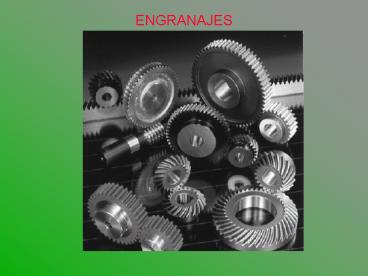ENGRANAJES PowerPoint PPT Presentation
Title: ENGRANAJES
1
ENGRANAJES
2
RUEDAS RECTAS
ENGRANAJE RECTO
- Valores Caracteristicos
- Número de dientes, z
- Módulo, m en mm
- Paso ? m
3
NOMENCLATURA
DIMENSIONES
- Diámetro medio D m z
- Diámetro de cabeza D m (z2)
- Diámetro de fondo D m (z-2,5)
4
RUEDAS RECTAS
ENGRANAJE RECTO
5
Geometría de las ruedas rectas
6
RUEDAS RECTAS
FUERZAS GENERADAS Fuerza Tangencial Ft Mt /
R Fuerza Radial Fr Ft Tg ? ?, ángulo de
contacto. Valor habitual, ?20º
7
RUEDAS HELICOIDALES
- Valores Caracteristicos
- Número de dientes, z
- Módulo, m en mm
- Paso ? m
- ?a, ángulo de hélice.
- Valores habituales de 15º
- 20º
- Diámetro medio D ma z
- Diámetro de cabeza D ma (z2)
- Diámetro de fondo D ma (z-2,5)
DIMENSIONES
Módulo aparente ma m / cos ?a
8
RUEDAS HELICOIDALES
FUERZAS GENERADAS Fuerza Tangencial Ft Mt /
Ra Fuerza Radial Fr Ft Tg ?a Tg ?a Tg ?
/ Cos ?a Fuerza axial Fr Ft Tg ?a
9
RUEDAS CONICAS
- Valores Caracteristicos
- Número de dientes, z
- Módulo, m medio en mm
- Paso ? m
- ?1 - ?2, ángulos de paso.
- Ejes perpendiculares
- ?1 ?2 90º
- Diámetro medio D m z
- Diámetro de cabeza D m (z2)
- Diámetro de fondo D m (z-2,5)
DIMENSIONES
10
RUEDAS CONICAS
FUERZAS GENERADAS Fuerza Tangencial Ft Mt /
Rmedio Fuerza Radial Fr Ft Tg ? Cos
? Fuerza axial Fr Ft Tg ? Sen ?
11
Aplicación de los diferentes tipos de ruedas
En la figura se muestra una batidora industrial,
en la que podemos ver los diferentes tipos de
engranajes.
12
Engranaje, tornillo sin fín
a.) de dientes cilíndricos b.) doble envolvente.
13
Pasos diametrales preferidos
Pasos diametrales preferidos para cuatro clases
de dientes
14
Pasos diametrales
Pasos diametrales estándares comparados con el
tamaño del diente. Se supone un tamaño real
15
Addendum, Dedendum and Clearance
Table 14.2 Formulas for addendum, dedendum, and
clearance (pressure angle 20, full-depth
involute.)
Text Reference Table 14.2, page 623
16
Pitch and Base Circles
Figure 14.8 Pitch and base circles for pinion
and gear as well as line of action and pressure
angle.
Text Reference Figure 14.8, page 624
17
Involute Curve
Figure 14.9 Construction of involute curve.
Text Reference Figure 14.9, page 625
18
Contact Ratio
Figure 14.10 Illustration of parameters
important in defining contact ratio.
Text Reference Figure 14.10, page 629
19
Line of Action
Figure 14.11 Details of line of action, showing
angles of approach and recess for both pinion and
gear.
Text Reference Figure 14.11, page 629
20
Backlash
Figure 14.12 Illustration of backlash in gears.
Text Reference Figure 14.12, page 632
21
Recommended Minimum Backlash
Table 14.3 Recommended minimum backlash for
coarse-pitch gears.
Text Reference Table 14.3, page 633
22
Externally Meshing Spur Gears
Figure 14.13 Externally meshing spur gears.
Text Reference Figure 14.13, page 635
23
Internally Meshing Spur Gears
Figure 14.14 Internally meshing spur gears.
Text Reference Figure 14.14, page 635
24
Simple Gear Train
Figure 14.15 Simple gear train.
Text Reference Figure 14.15, page 636
25
Compound Gear Train
Figure 14.16 Compound gear train.
Text Reference Figure 14.16, page 636
26
Example 14.7
Figure 14.17 Gear train used in Example 14.7.
Text Reference Figure 14.17, page 637
27
Allowable Bending Stress vs. Brinell Hardness
Figure 14.18 Effect of Brinell hardness on
allowable bending stress for two grades of
through-hardened steel ANSI/AGMA Standard
1012-F90, Gear Nomenclature, Definition of Terms
with Symbols, American Gear Manufacturing
Association, 1990.
Text Reference Figure 14.18, page 638
28
Contact Stress vs. Brinell Hardness
Figure 14.19 Effect of Brinell Hardness on
allowable contact stress for two grades of
through-hardened steel. ANSI/AGMA Standard
1012-F90, Gear Nomenclature, Definition of Terms
with Symbols, American Gear Manufacturing
Association, 1990.
Text Reference Figure 14.19, page 639
29
Forces on Gear Tooth
Figure 14.20 Forces acting on individual gear
tooth.
Text Reference Figure 14.20, page 640
30
Bending Stresses
Figure 14.21 Forces and length dimensions used
in determining bending tooth stresses. (a)
Tooth (b) cantilevered beam.
Text Reference Figure 14.20, page 641
31
Lewis Form Factors
Table 14.4 Lewis form factors for various
numbers of teeth (pressure angle 20, full depth
involute).
Text Reference Table 14.4, page 642
32
Spur Gear Geometry Factors
Figure 14.22 Spur gear geometry factors for
pressure angle of 20 and full-depth involute.
ANSI/AGMA Standard 1012-F90, Gear Nomenclature,
Definition of Terms with Symbols, American Gear
Manufacturing Association, 1990.
Text Reference Figure 14.21, page 643
33
Application Factor
Table 14.5 Application factor as a function of
driving power source and driven machine.
Text Reference Table 14.5, page 643
34
Size Factor
Table 14.6 Size factor as a function of
diametral pitch or module.
Text Reference Table 14.6, page 644
35
Load Distribution Factor
Figure 14.23 Load distribution factor as
function of face width and ratio of face width to
pitch diameters. Commercial quality gears
assumed. From Mott (1992).
Text Reference Figure 14.23, page 645
36
Dynamic Factor
Figure 14.24 Dynamic factor as function of
pitch-line velocity and transmission accuracy
level number.
Text Reference Figure 14.24, page 645
37
Helical Gear
Figure 14.25 Helical gear. (a) Front view (b)
side view.
Text Reference Figure 14.25, page 651
38
Pitches of Helical Gears
Figure 14.26 Pitches of helical gears. (a)
Circular (b) axial.
Text Reference Figure 14.26, page 652
39
Motor Torque and Speed
Figure 14.28 Torque and speed of motor as
function of current for industrial mixer used in
case study.
Text Reference Figure 14.28, page 655

